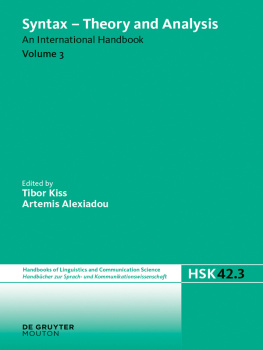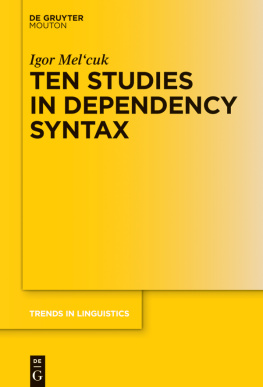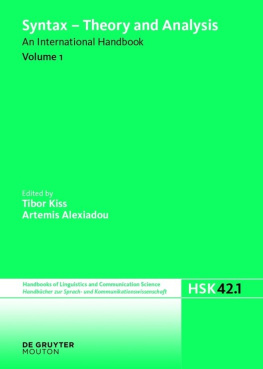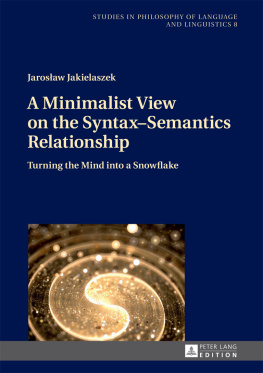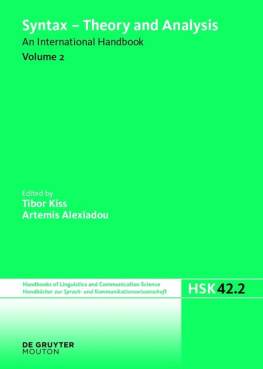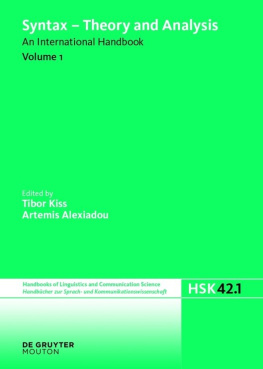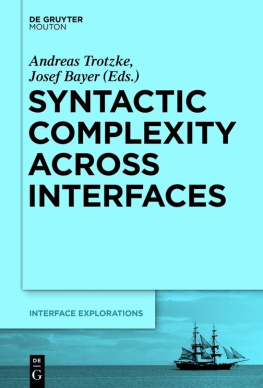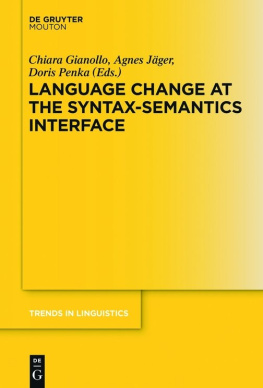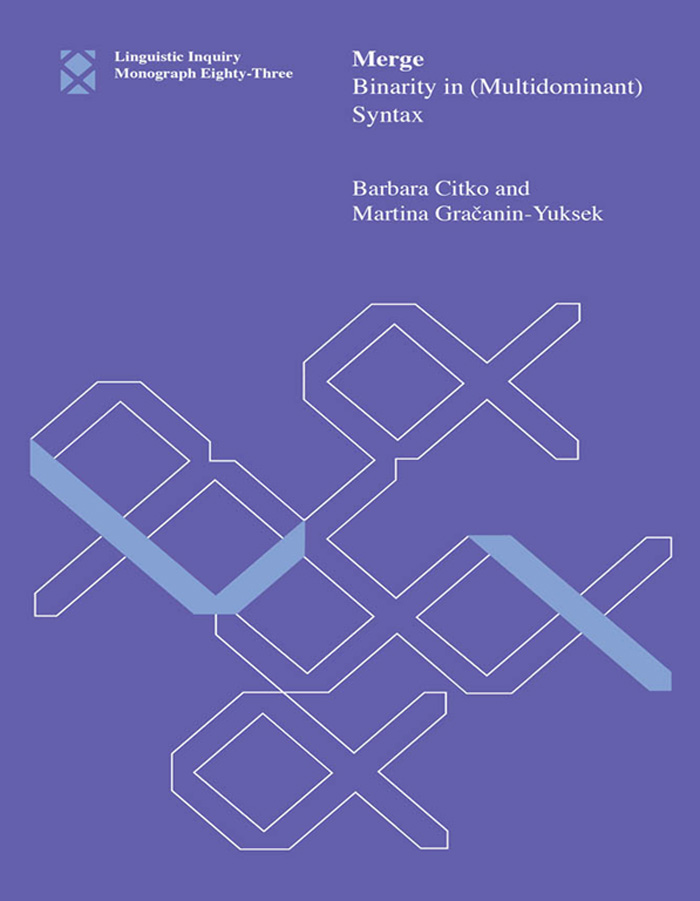
Merge
Linguistic Inquiry Monographs
Samuel Jay Keyser, general editor
A complete list of books published in the Linguistic Inquiry Monographs series appears at the back of this book.
Merge
Binarity in (Multidominant) Syntax
Barbara Citko and Martina Graanin-Yuksek
The MIT Press
Cambridge, Massachusetts
London, England
2020 Massachusetts Institute of Technology
All rights reserved. No part of this book may be reproduced in any form by any electronic or mechanical means (including photocopying, recording, or information storage and retrieval) without permission in writing from the publisher.
This book was set in Times New Roman by New Best-set Typesetters Ltd.
Library of Congress Cataloging-in-Publication Data
Names: Citko, Barbara, 1970 author. | Graanin-Yuksek, Martina, author.
Title: Merge : binarity in (multidominant) syntax / Barbara Citko, Martina Graanin-Yuksek.
Description: Cambridge : The MIT Press, 2020. | Series: Linguistic inquiry monographs ; 83 | Includes bibliographical references and index.
Identifiers: LCCN 2020004636 | ISBN 9780262044790 (hardcover) | ISBN 9780262539869 (paperback)
Subjects: LCSH: Grammar, Comparative and generalSyntax. | Parallelism (Linguistics)
Classification: LCC P291 .C563 2020 | DDC 415dc23
LC record available at https://lccn.loc.gov/2020004636
10 9 8 7 6 5 4 3 2 1
d_r0
Contents
Series Foreword
We are pleased to present the eighty-third volume in the series Linguistic Inquiry Monographs. These monographs present new and original research beyond the scope of the article. We hope they will benefit our field by bringing to it perspectives that will stimulate further research and insight.
Originally published in limited edition, the Linguistic Inquiry Monographs are now more widely available. This change is due to the great interest engendered by the series and by the needs of a growing readership. The editors thank the readers for their support and welcome suggestions about future directions for the series.
Samuel Jay Keyser
for the Editorial Board
Acknowledgments
It was in May 2016 that the two of us sat together in Ithaca, New York, and decided to extend the scope of our work and write a monograph. Since then, the research presented in the book has evolved enormously. In the process, versions of it have been presented in several venues and have profited from comments made by many people that we would like to thank for their support. We would like to start with our editor Marc Lowenthal. Marc was encouraging from the very start of our project and has been an invaluable guide through the entire process. We are also greatly indebted to the three MIT Press reviewers for their very thoughtful and detailed comments and suggestions, as well as for constructive criticisms that led to substantial improvements in the final version. Our special thanks go to the reviewer who we know as Reviewer 3 for a meticulous evaluation of our work and for all the ideas included in the review, many of which are now part of the book. Finally, we would like to thank Anne Mark for being not only fantastically quick and thorough in her copyediting, but also extremely approachable and friendly during the whole process.
Between the inception of the monograph and its publication, we presented its content (or parts of it) to various audiences. We would like to acknowledge them here: the audience at NELS (North East Linguistic Society) 48, held at the University of Iceland (October 2017), where we first presented our Binarity Constraint on Merge; the audiences at colloquia at New York University (May 2017) and the University of Leipzig (January 2018); the audience who came to see our poster at the Crete Summer School in Linguistics (July 2018); the audience at the Morphology and Syntax Workshop at the University of Chicago (December 2018), where Barbara presented the core research ideas in this monograph; and finally, the audience at the colloquium series of the Department of Theoretical and Applied Linguistics at Lomonosov Moscow State University (September 2019), where Martina presented a postreview version of the monograph. We would like to particularly acknowledge the comments and questions of the following members of these audiences: Karlos Arregi, Benjamin Bruening, Ksenia Ershova, Stefan Keine, Julie Anne Legate, Jason Merchant, Gereon Mller, Andy Murphy, Eszter Ronai, Philippe Schlenker, Laura Stigliano, Sandhya Sundaresan, Anna Szabolcsi, Michelle Yuan, and Erik Zyman.
Besides these formal occasions on which we had an opportunity to present our work, we discussed it with a number of people in more informal settings; we would like to thank Kyle Johnson, Roni Katzir, and Umut zge for discussion of various aspects of our proposal. We would like to thank David Pesetsky for his comments on the book prospectus, and Kyle Johnson for teaching a very inspiring course on movement and multidominance at the Crete Summer School, which Barbara attended. Special thanks go to colleagues who helped us with grammaticality judgments in Croatian, English, and Polish. We apologize to anyone we omitted, and we alone are responsible for any omissions, misrepresentations, or remaining mistakes.
Finally, we would each like to thank our families and home institutions for their support throughout this process. Barbara would like to thank her husband Randy for his unwavering support, her colleagues and students at the University of Washington for creating a collegial work atmosphere, the Helen Riaboff Whiteley Center on San Juan Island (where portions of the monograph were written) for providing occasional necessary respite from everyday life, and the University of Washington for granting her a sabbatical leave in 20182019.
Martina is grateful to her husband Eray, her son Jan, her mum Grozdana, and her dad Emil (who, unfortunately, is no longer here to witness the final product, but whose memory this book honors), for graciously accepting the long hours of Skyping with Barbara, endless writing, rewriting, editing, and more, and for cheering her on throughout this journey. Heartfelt thanks go to the people in the Department of English Language Teaching at Middle East Technical University for their friendship and support.
1Introduction
Our main goal in this monograph is to explore properties of Merge against the backdrop of multidominant syntax. While research on multidominance to date has led to a number of important theoretical and empirical insights regarding the properties, linearization, and interpretation of multidominant structures (Moltmann 1992; Wilder 1999, 2008; Citko 2000, 2005, 2011a, b; Graanin-Yuksek 2007, 2013; Bachrach and Katzir 2009, 2017; De Vries 2009, 2013b; Johnson 2012, 2018, among many others), there have been fewer attempts to capitalize on the specific properties of multidominant derivations and representations in order to advance the understanding of Merge itself. In this monograph, we aim to remedy this gap.
We assume the syntactic architecture whereby Merge, the basic structure-building operation in Minimalist syntax, has the ability to create multidominant structures. We also assume that the two types of Merge responsible for creating multidominant structures are Internal Merge and Parallel Merge. Following Chomsky (2004), we take Internal Merge to be a way to capture syntactic displacement/movement. However, we take the term Internal Merge quite literally and assume that the moving element (such as B in (1ab)), instead of being copied and pasted into its new position, as shown in (1a), is simply remerged in a new position, as shown in (1b) (Engdahl 1980; Starke 2001; Grtner 2002; Zhang 2004; Johnson 2012, 2018, among others).
Next page

